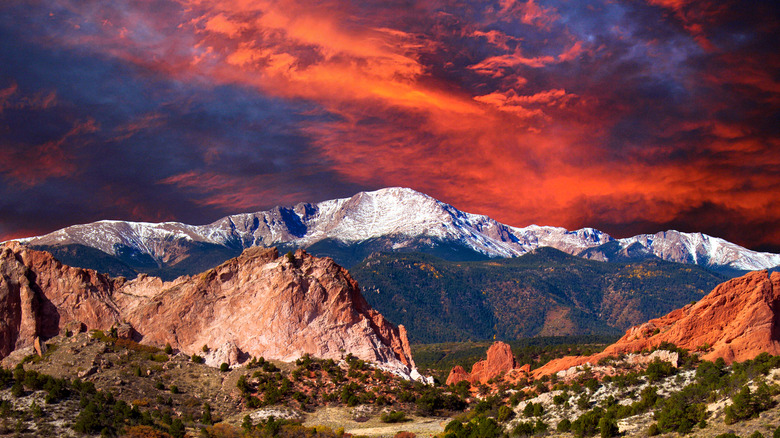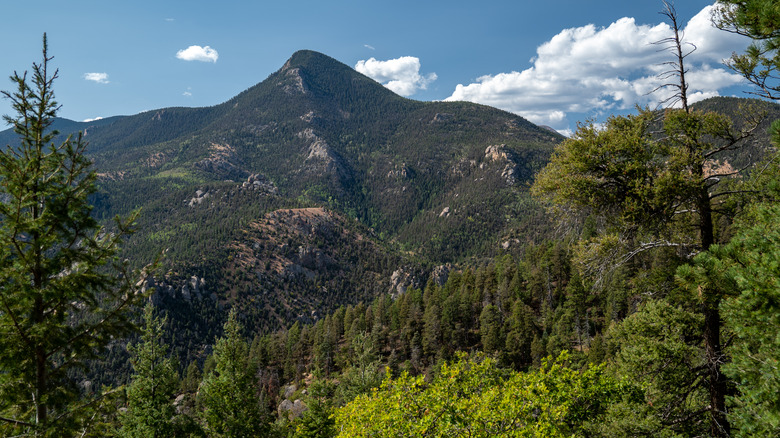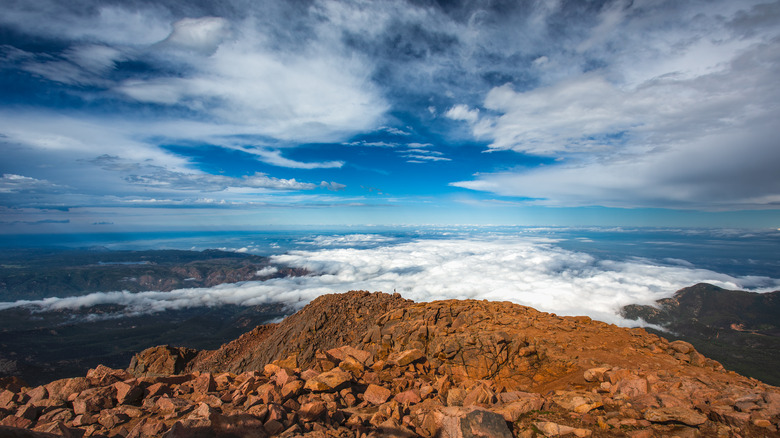This Beautiful Western Mountain Trail Is Considered One Of The Most Dangerous In America
Nowadays, we use the term "trailblazer" to acknowledge all kinds of feats. It could be a scientist making a breakthrough in medicine, a rock band pioneering a new sound, or a sports star setting a new record. Portland even has a basketball team named the Trail Blazers, although their moniker is more related to the original meaning of the term than success on the court. It refers to the Lewis and Clark Expedition, which ended near what is now Portland. The word "trailblazer" comes from the 18th century when intrepid explorers literally blazed a trail through the wilds of the United States.
One such adventurer's name is immortalized by one of the nation's most dangerous hikes — The Barr Trail in Colorado. The trail is a demanding 26-mile round trip from Manitou Springs to Pikes Peak, which stands at 14,115 feet in the Rocky Mountains. Despite its difficulty, it is a well-traveled route; for that, we have to thank its creator, Fred Barr. Barr was a local man who ran a business giving burro rides to tourists; and, beginning in 1914, he started planning a new trail to the summit of Pikes Peak. He completed his survey of the route in 1918 and development finished three years later; he then moved on to building Barr Camp at 10,200 feet for overnight stays. Over a century on, the trail is still one of the most popular in the Rockies; but it is a serious trek that mustn't be taken lightly.
Why is the Barr Trail dangerous?
One of the biggest risk factors hikers may encounter while tackling the Barr Trail is its unpredictable weather. The route ascends almost 8,000 feet over the course of 13 miles and weather conditions become more changeable the higher you get. The Rocky Mountains are known for thunderstorms and Pikes Peak attracts a lot of electrical activity as a combination of air currents, altitude, and winds blowing in off the plains create a hotspot for lightning storms.
Local experts warn that the weather on Pikes Peak is "dangerously unpredictable" and that hikers should turn back if they see storm clouds developing, which can happen very quickly. Anyone heading up the Barr Trail should set out early in the day to avoid storms that are common in the afternoon during the summer months. Much of the trail is above the tree line, meaning that hikers have no cover and are prone to strikes. If you are unfortunate enough to get caught out in the middle of a lightning storm, you should seek shelter between boulders or well-forested areas, discard metal objects, and avoid open stretches and solitary trees.
People have lost their lives due to lightning strikes on Barr Trail in the past. One victim was 18-year-old Frazee Waltman, who was killed by a lightning strike on the trail just 100 feet below the summit. His two friends were unscathed. Prior to Waltman's death, 61 people had died by lightning strikes in Colorado since 1980.
Other dangers on the Barr Trail
Apart from the threat of lightning strikes, trekking the Barr Trail is a serious undertaking and should be treated as such. Hikers should be in a good enough physical condition to manage a 26-mile round trip across steep and rocky terrain; local sources warn that you should not rely on a pickup from the top as unforeseen circumstances might result in road closure. A two-day trip with an overnight stay at Barr Camp is recommended for inexperienced hikers.
Anyone attempting the route should make sure that they are fully equipped and appropriately dressed; while temperatures at the start of the trail may be very hot in the summer, wintry conditions may be experienced near the summit all year round. This means people who aren't dressed for the occasion run the risk of hypothermia. Needless to say, you shouldn't get distracted by the stunning views at any point as the risk of fatal accidents is also a threat — a 31-year-old woman perished in 2018 when she fell near the summit.
All that may sound daunting, but these perils should not deter you. Around 150,000 people hit the Barr Trail every year and it is even the venue for the annual Pikes Peak Marathon, so if you take the proper precautions there is absolutely no reason why you can't strike this iconic hiking route off your checklist.


